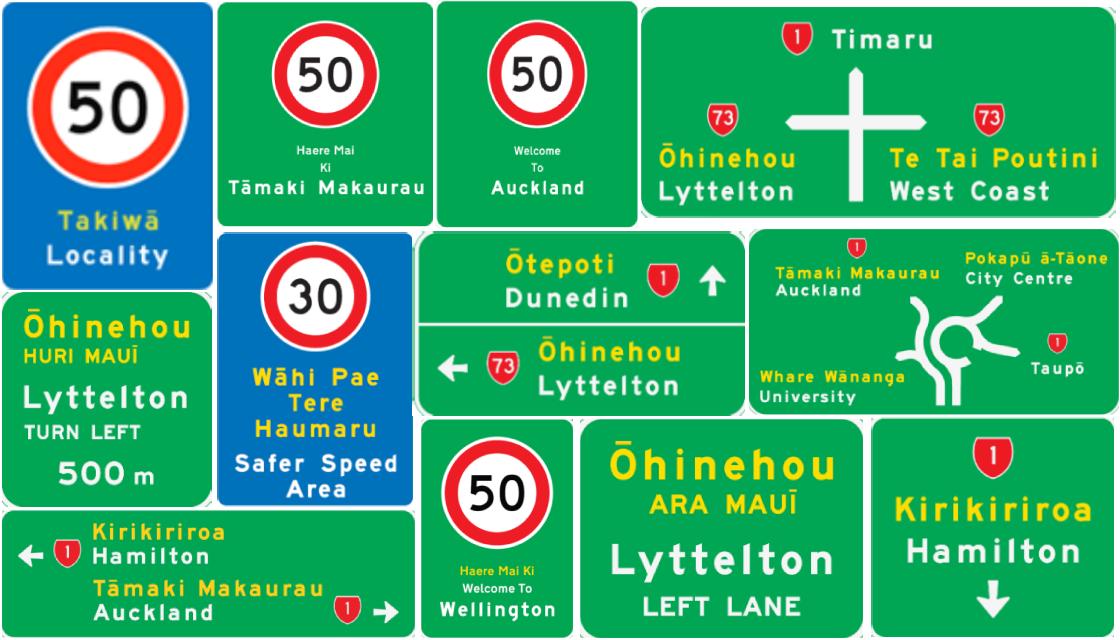Public consultation has opened for the proposed bilingual traffic signs that could be on Aotearoa New Zealand's roads soon.
Te Mātāwai and Waka Kotahi NZ Transport Agency are leading a programme of work to enable more use of te reo Māori on traffic signs around the country. Te Mātāwai is the independent entity that works on behalf of iwi and Māori for the revitalisation of te reo Māori.
A panel of te reo Māori experts, Te Pae Whakamāori, considered and decided on translations that went through a moderation process, facilitated by Te Mātāwai. Waka Kotahi said the mana of te reo Māori, the safety of the hapori (community), and consistency across the country were key considerations.
They said there is evidence that bilingual signs, bilingual traffic signs, and similar initiatives have wide-ranging benefits, including safety enhancement, tourism promotion, language protection, cultural enhancement, and enhanced social cohesion.
Te Mātāwai board co-chair Reikura Kahi said last week that using te reo Māori on traffic signs will help ensure the language is visible at a community level where whānau live and play and its mana is affirmed and recognised.
"Affirming the status of te reo and enabling community engagement are critical drivers of language revitalisation so we celebrate this moment," Kahi said.
"Bilingual signage is an important step towards affirming the indigenous status of te reo Māori in Aotearoa. Increasing awareness and access to te reo Māori in our communities and cities is also a launchpad from which new iwi language initiatives targeting new generations can grow together."
The proposals cover 94 signs and are grouped by type:
- destination signs
- public and active transport signs
- walking and cycling wayfinding signs
- general advisory and permanent warning signs
- motorway and expressway advisory signs
- temporary warning signs.
This consultation follows rule changes last year that saw the introduction of Kura School traffic signs.
The rollout of this package of bilingual signs would begin with signs that need to be replaced, particularly in hard-hit regions where they were damaged during the cyclone and new ones are needed, Waka Kotahi said.
The public can submit feedback and see further information here.
Examples of the proposed signs are below and are grouped by type.
Destination signs
Destination signs inform road users of directions and distances to destinations and are commonly seen throughout the roading network. Some of these destination signs include a speed threshold.
For these proposals, colour will be used to differentiate between the two languages, with te reo Māori in yellow and English in white.
There are 17 proposed bilingual traffic signs.


Public and active transport signs
Public and active transport signs show information about special vehicle routes, such as bus and cycle routes.
These signs are "relatively simple", the Waka Kotahi proposal report said, and use mostly symbols to convey information, with minimal text.
There are two different ways of differentiating between te reo Māori and English for these signs.
For some signs, such as bus and cycle ‘lane’ or ‘only’ signs, all capital letters are currently used for English, so it is proposed that capital case is maintained and te reo Māori is differentiated using one font size up from the English.
For the bus stop and coach stop signs, colour is the method proposed to differentiate te reo Māori and English, with black and red to be used, respectively.
There are seven proposed bilingual traffic signs, with the bus and coach signs considered as one same design.

Walking and cycling wayfinding signs
These signs give directional information to people using active modes of transport, such as walking and cycling.
Wayfinding signs are usually found on shared paths and cycleways.
The proposed bilingual signs will use colour to differentiate between te reo Māori (black text) and English (blue text).
There are six proposed bilingual traffic signs.

General advisory and permanent warning signs
These signs give information about features adjacent to roads and warn of associated hazards.
The two languages would be differentiated by te reo Māori being one case size larger than English.
There are 10 proposed bilingual traffic signs.

Motorway and expressway advisory signs
These signs give information about motorways and expressways.
Te reo Māori will be differentiated from English by being one case size larger.
There are 12 proposed bilingual traffic signs.

Temporary warning signs
Temporary traffic management signs are used by contractors to make sure there's safe management of traffic around their worksite.
The two languages on these signs will be differentiated through different case types, with te reo Māori displayed in sentence case and English in upper case. Waka Kotahi said sentence case differentiation has been used to minimise the size increase of the bilingual temporary signs, which is crucial for signs that are used on roads with a higher crash risk.
There are 42 proposed bilingual traffic signs.




Other proposed changes
Waka Kotahi is also proposing some "consequential and/or minor changes" to be made to the Traffic Control Devices (TCD) Rule as part of this change.
This includes some changes to the shape and size of signs, changes to border sizes, changes to colours and text size, and formatting specifications for macrons.


